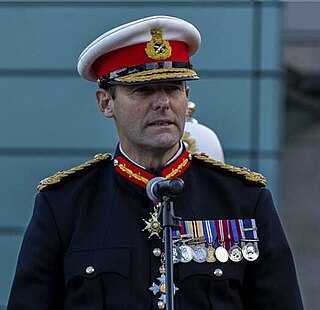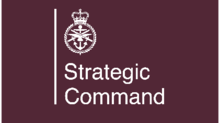
The Royal Air Force (RAF) is the United Kingdom's air and space force. It was formed towards the end of the First World War on 1 April 1918, becoming the first independent air force in the world, by merging the Royal Flying Corps (RFC) and the Royal Naval Air Service (RNAS). Following the Allied victory over the Central Powers in 1918, the RAF emerged as the largest air force in the world at the time. Since its formation, the RAF has played a significant role in British military history. In particular, during the Second World War, the RAF established air superiority over Hermann Göring's Luftwaffe during the Battle of Britain, and led the Allied strategic bombing effort.

The Ministry of Defence is the department responsible for implementing the defence policy set by His Majesty's Government, and is the headquarters of the British Armed Forces.

Defence Intelligence (DI) is an organisation within the United Kingdom intelligence community which focuses on gathering and analysing military intelligence. It differs from the UK's intelligence agencies in that it is an integral part of a government department – the Ministry of Defence (MoD) – rather than a stand-alone organisation. The organisation employs a mixture of civilian and military staff and is funded within the UK's defence budget. The organisation was formerly known as the Defence Intelligence Staff (DIS), but changed its name in 2009.

The Permanent Joint Headquarters (PJHQ) is the British tri-service headquarters from where all overseas military operations are planned and controlled. It is situated at Northwood Headquarters in Northwood, London. The Permanent Joint Headquarters is commanded by the Chief of Joint Operations (CJO), the position of which is currently held by Lieutenant General Charles Stickland.

Joint Services Command and Staff College (JSCSC) is a British military academic establishment providing training and education to experienced officers of the Royal Navy, Army, Royal Air Force, Ministry of Defence Civil Service, and serving officers of other states.

The Joint Helicopter Command (JHC) is a tri-service organisation uniting battlefield military helicopters of the British Armed Forces for command and coordination purposes.

Northwood Headquarters is a military headquarters facility of the British Armed Forces in Eastbury, Hertfordshire, England, adjacent to the London suburb of Northwood. It is home to the following military command and control functions:
- Headquarters, Strategic Command, formerly Joint Forces Command
- Permanent Joint Headquarters
- Commander Operations for the Royal Navy
- NATO Allied Maritime Command

Defence Equipment and Support (DE&S) is a trading entity and joint-defence organisation within the UK Ministry of Defence. It began operating on 2 April 2007, following the merger of the MoD's Defence Procurement Agency and the Defence Logistics Organisation, under the Chief Executive Officer of Defence Equipment and Support.
Director Special Forces (DSF) is the senior British Armed Forces officer responsible for Special Forces. The post is a senior role within the Ministry of Defence (MoD). As Director, the incumbent is responsible for the provision of United Kingdom Special Forces (UKSF) capability to MoD, and holds Operational Command for discrete Special Forces operations.
The Australian Defence Organisation (ADO) is composed of the armed forces of the Commonwealth of Australia, the Australian Defence Force (ADF), and the Australian Public Service government department, the Department of Defence which is composed of a range of civilian support organisations.
The Australian Defence Organisation (ADO) is composed of the armed forces of the Commonwealth of Australia, the Australian Defence Force (ADF), and the Australian Public Service government department, the Department of Defence which is composed of a range of civilian support organisations.

The Navy Command is the current headquarters body of the Royal Navy, and as of 2012 its major organisational grouping. It is a hybrid, neither a command, nor simply an installation. Royal Navy official writings describe Navy Command Headquarters both as a physical site, on Whale Island, Hampshire, a collective formed of the most senior RN officers, and as a budgetary grouping.
The Defence Intelligence Fusion Centre (DIFC) is based at RAF Wyton in Cambridgeshire. Largely created from the staff of the National Imagery Exploitation Centre and then known for several years as the Defence Geospatial Intelligence Fusion Centre, it can trace its history back to clandestine reconnaissance operations at the beginning of the Second World War by Sydney Cotton on behalf of MI6 and then MI4, and the formation of the Allied Central Interpretation Unit at RAF Medmenham.

The page contains the current structure of the British Army. The British Army is currently being reorganised to the Future Soldier structure.

Lieutenant General Sir Robert Andrew Magowan, is a senior Royal Marines officer who serves as the Deputy Chief of the Defence Staff since May 2022. He previously served as Commandant General Royal Marines from 2016 to 2017 and again from 2021 to 2022.
The Chief of Joint Capabilities (CJC) is the head of the Joint Capabilities Group (JCG) in the Australian Department of Defence. The Joint Capabilities Group was raised on 1 July 2017 with the position created as a result, with the inaugural CJC being Air Marshal Warren McDonald. The current chief is Lieutenant General John Frewen, who was appointed to the position in August 2022.
This is the structure of the British Armed Forces, as of October 2021.

United Kingdom Space Command (UKSC) is a joint command of the British Armed Forces organised under the Royal Air Force, and staffed by personnel from the Royal Navy, British Army, Royal Air Force and the British Civil Service. The UKSC has three functions: space operations, space workforce generation, and space capability.

Air Marshal John Jackson Stringer is a senior Royal Air Force officer. Since August 2022 he has been Deputy Commander, Allied Air Command.






















